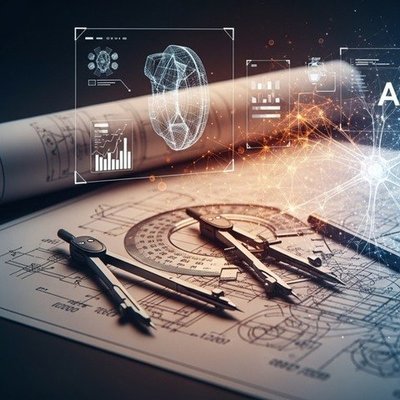In a business built on expertise—deep, domain-specific knowledge of product development—the rise of AI challenges some of our most fundamental assumptions. If expertise is suddenly more widely accessible and automated, we must ask: How do we, as experts, continue to differentiate ourselves? How do we evolve in a world where information and insights are no longer scarce but instantly retrievable?
That was the starting point for me. I began asking my team: How are we using these tools? What’s happening under the hood? It turned out quite a bit. Our software engineers—those writing code for embedded systems or user interfaces—were already tapping into AI to debug, generate test scripts, and validate their logic. “You mean it’s building code?” I marvelled. And that was my moment. I had to jump in.
I’m a mechanical engineer, not a programmer. But I wondered if AI could enable me to instantly become a JavaScript expert. At least enough of one to build a checkers game. One May 2023 afternoon later, I had a working prototype and an epiphany on par with the first time I saw Netscape in 1995. Watching ChatGPT create functional scripts was a personal eye-opener. I saw, firsthand, how AI democratizes access to tools and knowledge. Practically, it’s no longer about whether you’ve studied a subject for years; it’s about whether you are curious enough to create the first prompt and follow through on the necessary iterations to achieve something new.
Editor’s Note: This essay is part of a new series exploring how AI is transforming the way physical products are imagined, designed, and built. Hardware is the New Salt will spotlight several thinkers and makers at the intersection of AI and product design and their insights into this dynamic technology ecosystem. This series is supported by Enzzo, who offers an AI-first product development platform created to support the next generation of builders.
I don’t mean to imply that this last realization settled in instantly. Initially, my reaction to AI was to fear the new world order. But over time, that gave way to curiosity—and now, optimism. What we’ve gained is not just a faster way to code or draft, but a fundamentally new way to access, structure, and navigate knowledge. In our line of work, where entrepreneurs walk in the door with wildly diverse backgrounds—surgeons, chemists, software developers—AI lets me rapidly get up to speed. In just a few prompts, I can synthesize enough of their world to ask better questions and add more value. We hear about frontier labs working to “align” their models to expectations of etiquette, bias and safety. A consulting firm must re-align constantly, with customer A talking fluid dynamics and customer B diving deep on medical power systems. The faster we can get past the vocabulary to a place of shared understanding of priorities the sooner we get to the meaningful human interactions. Used correctly, AI facilitates this, and that is transformative.
There’s no question AI democratizes design. Anyone with the right prompt can gain vocabulary, context, and ideas in fields they’ve never worked in. That can be extraordinary—or chaotic. The beauty is that AI can organize disordered inputs, establish structure, and frame problems in new ways. Where we used to spend the first two weeks of a product engagement just framing the challenge, AI can now do that in minutes.
Am I upset about losing that billable time? Not at all. The real value lies in moving faster toward the next decision. Product development is, after all, a series of decisions. Use metal or glass? Mold or machine? Merge or separate functions? Our job is to design and learn until we can answer those questions with confidence.
People always ask about speed. It’s become the headline feature of AI. But speed is nuanced. What I’ve seen isn’t that teams want to crank out more products—they want to do one product better. That’s where I see AI having the most significant impact: allowing us to go deeper, not just faster.
AI is already helping in the early and late stages of product development—intake, analysis, communication. Need to summarize data for stakeholders? Explain performance to a cross-functional team? We have great tools that really help by reducing time spent on those tasks. With that assistance we gain space to explore more options, test more hypotheses, and build a stronger product.
But let’s be honest: there’s still inertia. Product development isn’t just a process—it’s a culture. Expertise is built over decades. Teams rely on legacy workflows. And even when AI tools promise efficiency, they still require human trust to be used effectively.
One of the biggest hurdles is trust. As someone who’s immersed myself in these tools—building games, teaching courses, trying to stay at the bleeding edge—I’ve seen both the power and the pitfalls. Engineers are right to be cautious. Hallucinations are real. Bias is real. You can chase a bad idea for hours before realizing it’s just well-worded nonsense.
To build trust, we need processes that treat AI as a collaborator, not a decider. It should generate ideas, not conclusions. Experts still need to review, refine, and approve. The signature on the final product still belongs to a human. That accountability doesn’t go away.
So, where are we in the AI adoption curve? We’re in toddlerhood—but what a toddler! AI already shows an astonishing capacity to translate, reason, and organize. It’s skipping grades—but it hasn’t yet graduated. We have lacked the right tooling to apply the intelligence to the engineering problems. We don’t have a “K–12” system for AI to work within but it is coming fast with advancing model capabilities like function calling. The infrastructure—across engineering domains like thermal modelling, materials, and mechanisms—is still catching up.
Yet AI isn’t like past design technologies. This isn’t AutoCAD replacing Vellum, swapping a pencil for a mouse, or replacing a machine shop with a 3D printer. Those changes were significant but specific and still fit within the development frameworks and paradigms. How to use AI in product design is murkier but the opportunities to augment how we work are everywhere. It may not just be a new tool to replace an old one; it may enable workflows that never existed before. Neural nets are systems that produce outputs without clear explainability, surfacing ideas and insights in unexpected, sometimes unreliable ways. That unpredictability is both a power and a challenge. We don’t yet know precisely where it’s headed. And that’s the source of unease.
AI’s most profound impact may not fit within existing workflow paradigms at all. While it’s clear that LLMs can enhance discrete development steps like problem definition, research, and prototyping, the deeper question remains: what happens when AI begins generating solutions directly, seemingly from the ether? In the same way that diffusion models create recognizable images by iteratively removing noise, future AI development systems might leap to solutions without following traditional engineering workflows. This isn’t just a new tool replacing an old one—it’s the potential for entirely new approaches to solution-finding that could bypass steps we’ve long considered essential.
Yet the potential is real. AI will never fully imagine the future—that remains our job. But it can be the assistant that helps us arrive faster, better equipped, and more informed. Like Jarvis from Iron Man, AI’s promise is in augmentation. You still need the human in the loop—asking the questions, steering the direction, making the calls.
The Jarvis paradigm—AI as an augmenting partner rather than a replacement—remains my north star. Our partnership with Enzzo, to provide product management automation via our website, comes out of that same augmentation vision. And project Nancy represents another step toward this vision: an AI companion that knows our project history, understands our clients’ contexts, and surfaces relevant insights at decision points. But true partnership requires trust built through consistent, reliable collaboration.
Experiences with Enzzo and Nancy have taught me that successful AI integration isn’t about replacing human judgment—it’s about maximizing that judgment with better information. When teams can access the right context at the right moment, they make better decisions. When they can explore more options without drowning in possibilities, they arrive at stronger solutions. The signature on the final product still belongs to a human, but that human is now working with unprecedented support.
And maybe, in that evolving partnership between human insight and artificial intelligence, we’ll design not just faster products, but solutions to problems we never thought possible.
About the author:
Scott Thielman, PhD is Chief Technology Officer and Co-Founder of Product Creation Studio, where for over 25 years he has led product development for medical device innovators including Olympus, Cardinal Health, Advanced Bionics, and LumiThera. His work spans critical medical technologies—from deep brain stimulation systems and insulin delivery devices to ophthalmic therapy devices and automated molecular therapy systems.
At Product Creation Studio, Scott has guided teams through complex development challenges including human factors research, design for manufacturing, and regulatory preparation for Class II and Class III medical devices. Notable projects include LumiThera’s Valeda photobiomodulation device (successfully acquired by Alcon in 2025), neurosurgical repair devices, and needle-free vaccine delivery systems.
Scott’s technical foundation in control systems and optimization—developed during his PhD work at the University of Washington on electromagnetic suspension and composite flywheel design—provided early exposure to the mathematical principles underlying modern AI. Since 2023, he has actively integrated AI tools into Product Creation Studio’s workflows, developing custom applications for CRM reporting and proposal automation. As an Affiliate Assistant Professor at UW Bothell, he created and taught a course on AI in Product Engineering, helping students apply these tools to real-world engineering challenges








